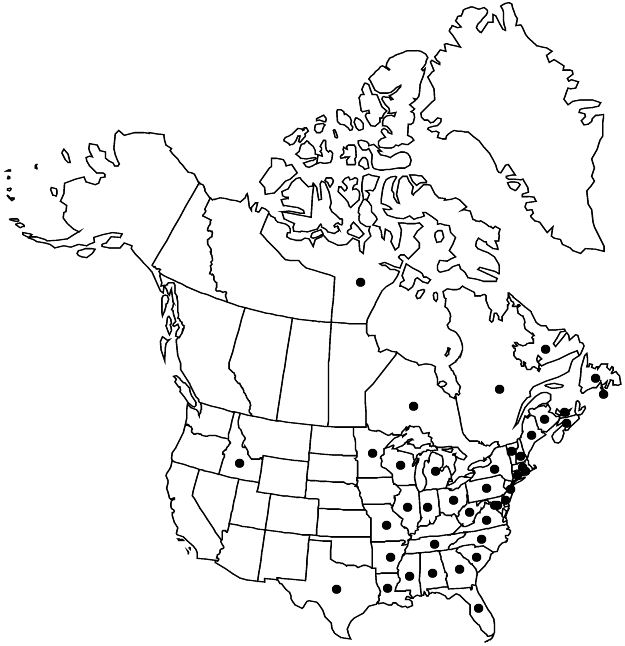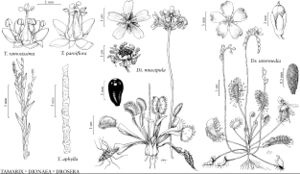Drosera intermedia
J. F. P. Dreves and F. G. Hayne, Bot. Bilderb. 3: 18, plate 3B. 1798.
Plants forming winter hibernaculae, rosettes 3–6 cm diam. in young plants only; stem base not bulbous-cormose; stem 1–8 (–20) cm (other species do not have distinct stem). Leaves erect to spreading, becoming widely separated outward at base before growing upwards; scapes (2–) 5–20 (–25) cm, glabrous. Flowers 7–12 mm diam.; sepals connate basally, oblong, 5–6 × 1–1.5 mm, glabrous; petals white, sometimes pink-tinged, obovate, 3–6 × 3–5 mm, apical margins erose. Capsules 4–5 mm. Seeds reddish-brown, oblong-obovoid, 0.7–1 mm, densely, uniformly papillose. 2n = 20.
Phenology: Flowering Jun–Aug.
Habitat: Wet habitats, often in several cm of water, including peat bogs, beaver ponds, and wetland margins, often on wet logs (north), wet margins of streams, ponds, bays, and ditches (south)
Elevation: 0–500 m
Distribution

St. Pierre and Miquelon, N.B., Nfld. and Labr., N.S., Nunavut, Ont., P.E.I., Que., Ala., Ark., Conn., Del., D.C., Fla., Ga., Idaho, Ill., Ind., La., Maine, Md., Mass., Mich., Minn., Miss., Mo., N.H., N.J., N.Y., N.C., Ohio, Pa., R.I., S.C., Tenn., Tex., Vt., Va., W.Va., Wis., West Indies, Central America, South America, Eurasia
Discussion
Drosera intermedia is the only species of the genus with a distinct stem, scattered cauline leaves, and an arching scape. Its habit of growing in the wettest places, often in standing water, is characteristic. The stems are longer in deeper water and may be up to 20 cm in the southern part of its range. The winter hibernaculae form at the tips of the elevated stems; they will fall to the ground and sprout the following spring. The plants may reproduce vegetatively by forming plantlets in place of flower parts. The plantlets can be rooted, and in general this species is easy to grow.
M. L. Fernald (1950) recognized forma corymbosa (de Candolle) Fernald with a corymb instead of a raceme, and forma natans Heuser with floating stems up to 20 cm long.
Selected References
None.
